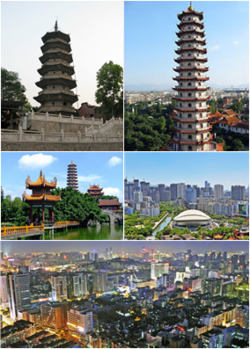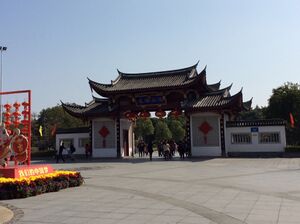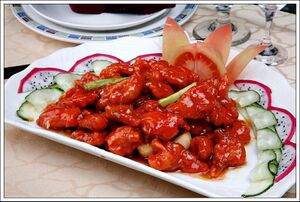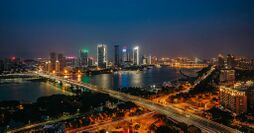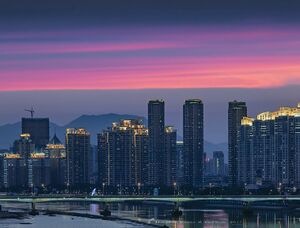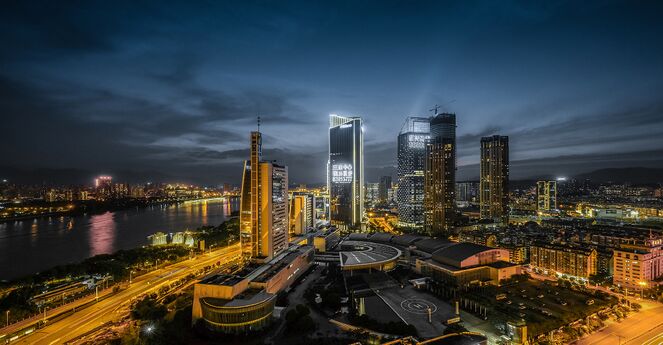فوتشو
| ||||||||||||||||||||||||||||||||||||||||||||||||||||||||||||||||||||
| ||||||||||||||||||||||||||||||||||||||||||||||||||||||||||||||||||||
| ||||||||||||||||||||||||||||||||||||||||||||||||||||||||||||||||||||
فوژو أو فوجو/فوتشو/فوزهو ( Fuzhou ؛ /fuːˈdʒoʊ/;[4] الصينية: 福州; پنين: Fúzhōu، وبلغة فوتشو المحلية: Hokchew, Hók-ciŭ)، وتـُرَوْمَن بشكل بديل كالتالي: Foochow، هي العاصمة وواحدة من أكبر المدن في مقاطعة فوجيان، بالصين.[5] تقع فوتشو بين Min River estuary to the south and the city of Ningde to the north. Together, Fuzhou and Ningde make up the Mindong linguistic and cultural region.
ويبلغ عدد سكانها 7,115,370 نسمة في تعداد 2010. Like other prefecture-level cities in China, its administrative area contains both urban and rural areas: in 2010, 61.95% of inhabitants (4,408,076) were urban, while 38.05% (2,707,294) were rural.[2] As of 31 December 2018, the total population was estimated at 7,740,000 whom 4,665,000 lived in the built-up (or metro) area made of five urban districts plus Minhou County.[6] In 2015, Fuzhou was ranked as the 10th fastest growing metropolitan area in the world by Brookings Institution.[7] Fuzhou is listed as No. 20 in the China Integrated City Index 2016's total ranking, a study conducted by the National Development and Reform Commission.[8]
Fuzhou is also a major city for scientific research, appearing in the global top 50 cities as tracked by the Nature Index.[9] The city is home to several major universities, notably Fuzhou University, one of China's key universities and other public universities, including Fujian Normal University and Fujian Agriculture and Forestry University.
تقع المدينة على نهر مين على بعد حوالي 50 كم من مَصَبِّ النهر. وفوژو أحد مراكز تجارة الشاي والكافور. في عام 1842م أصبحت ميناء المعاهدة التي كسبت فيها بريطانيا حقوقاً تجارية خاصَّة. وفقدت فوژو أهميتها بوصفها مركزاً تجارياً في أواخر القرن التاسع عشر، واحتلت القوات اليابانية المدينة عدة مرات خلال الحرب العالمية الثانية (1939 – 1945م). فوژو شهيرة بسلعها المطلية بطلاء اللاكيه الرائع، وتشمل منتجات المدينة أيضًا المواد الكيميائية الصناعية والمنتجات الإلكترونية.
الأسماء
Fuzhou is also known as "有福之州" (yǒufúzhīzhōu) in Chinese, meaning "a city of fortune". The Yuanhe Maps and Records of Prefectures and Counties, a Chinese geographical treatise published in the 9th century, says that Fuzhou's name came from Mount Futo a mountain northwest of the city. The mountain's name was then combined with -zhou, meaning "settlement" or "prefecture", in a manner similar to many other Chinese cities. During the Warring States period, the area of Fuzhou was sometimes referred to as Ye (الصينية: 冶), and Fuzhou was incorporated into China proper during Qin dynasty. The city's name was changed numerous times between the 3rd and 9th centuries before finally settling on Fuzhou in 948.[10] In Chinese, the city is sometimes referred to by the poetic nickname Rongcheng (الصينية: 榕城; Foochow Romanized: Ṳ̀ng-siàng), lit. 'The Banyan City'.
In older English publications, the name is variously romanized as Foochow, Foo-Chow,[11] Fuchow, Fūtsu, Fuh-Chow, Hock Chew, and Hokchew.
التاريخ
تاريخ ما قبل چين (قبل 221 ق.م.)
The remains of two Neolithic cultures—the Huqiutou Culture (虎丘頭文化), from around 5000 BC, and the Tanshi Mountain Culture (曇石山文化), from around 3000 BC—have been discovered and excavated in the Fuzhou area. During the Warring States period (c. 475–221 BC), Chinese began referring to the modern Fujian area as Min Yue (閩越), suggesting that the native inhabitants of the area were a branch of the Yue peoples, a diverse population of non-Chinese tribes who once inhabited most of southern China.[12] In 306 BC, the Yue Kingdom (present-day Zhejiang) fell to the state of Chu. Han Dynasty historian Sima Qian wrote that the surviving members of the Yue royal family fled south to what is now Fujian, where they settled alongside the native Yue people, joining Chinese and Yue culture to create Minyue.[13] Their major centre was not at Fuzhou's modern location, but further up the Min watershed near Wuyishan City.
أسرتا چين وهان (221 ق.م.–206م)
The First Emperor of Qin unified ancient China in 221 BC and desired to bring the southern and southeast regions under Chinese rule. The Qin dynasty organized its territory into "Commanderies" (الصينية: 郡; پنين: jùn)—roughly equivalent to a province or prefecture—and the Fujian area was organized as Minzhong Commandery (閩中郡). The area seems to have continued mostly independent of Chinese control for the next century. The Han dynasty followed the short-lived Qin, and Emperor Gaozu of Han declared both Minyue and neighboring Nanyue to be autonomous vassal kingdoms. In 202 BC, Emperor Gaozu enfeoffed a leader named Wuzhu (無諸; Old Chinese: Matya) as King of Minyue, and a walled city called Ye (冶; Old Chinese: Lya; literally: Beautiful) was built. The founding of Ye in 202 BC has become the traditional founding date of the city of Fuzhou.
In 110 BC, the armies of Emperor Wu of Han defeated the Minyue kingdom's armies during the Han–Minyue War and annexed its territory and people into China.[14] Many Minyue citizens were forcibly relocated into the Jianghuai area, and the Yue ethnic group was mostly assimilated into the Chinese, causing a sharp decline in Ye's inhabitants.[12] The area was eventually re-organized as a county in 85 BC.
الممالك الثلاث إلى أسرة سوي (200–618)

During the Three Kingdoms Period, southeast China was nominally under the control of Eastern Wu, and the Fuzhou area had a shipyard for the coastal and Yangtze River fleets. In 282, during the Jin dynasty, two artificial lakes known simply as the East Lake and West Lake were constructed in Ye, as well as a canal system. The core of modern Fuzhou grew around these three water systems, though the East and West Lakes no longer exist. In 308, during the War of the Eight Princes at the end of the Jin dynasty, the first large-scale migration of Chinese immigrants moved to the south and southeast of China began, followed by subsequent waves during later periods of warfare or natural disaster in the Chinese heartland. The administrative and economic center of the Fujian area began to shift to the Ye area during the Sui dynasty (581–618).
تانگ إلى فترة الممالك العشر (618–960)
In 725, the city was formally renamed "Fuzhou". Throughout the mid-Tang dynasty, Fuzhou's economic and cultural institutions grew and developed. The later years of the Tang saw a number of political upheavals in the Chinese heartland such as the An Lushan Rebellion and Huang Chao Rebellion, prompting another wave of northerners to immigrate to the modern-day Northern Min and Eastern Min areas. In 879, a large part of the city was captured by the army of Huang Chao during their rebellion against the Tang government. In 893, the warlord brothers Wang Chao and Wang Shenzhi captured Fuzhou in a rebellion against the Tang dynasty, successfully gaining control of the entire Fujian Province and eventually proclaiming their founding of an independent kingdom they called the Min Kingdom in 909. The Wang brothers enticed more immigrants from the north, though their kingdom only survived until 945. In 978, Fuzhou was incorporated into the newly founded Song dynasty, though their control of the mountainous regions was tenuous.
Fuzhou prospered during the Tang dynasty. Buddhism was quickly adopted by the citizens who quickly built many Buddhist temples in the area.
أسرة سونگ (960–1279)
Fuzhou underwent a major dramatic surge in its refined culture and educational institutions throughout the Song Dynasty as Fuzhou produced 10 Fuzhounese zhuangyuan scholars (scholar who is ranked the top first place in the imperial examinations zh:状元), a large number for a small city in the country during that dynasty.
The Hualin Temple (華林寺, not to be confused with the temple of the same name in Guangzhou), founded in 964, is one of the oldest surviving wooden structures in China. New city walls were built in 282, 901, 905, and 974, so the city had many layers of walls – more so than the Chinese capital. Emperor Taizong of the Song dynasty ordered the destruction of all the walls in Fuzhou in 978 but new walls were rebuilt later. The latest was built in 1371. During the Southern Song dynasty, Fuzhou became more prosperous; many scholars came to live and work. Among them were Zhu Xi, the most celebrated Chinese philosopher after Confucius, and Xin Qiji, the greatest composer of the ci form of poetry.
Marco Polo, an Italian guest of the Emperor Kubilai, transcribed, after the conventions of Italian orthography, the place name as Fugiu. This was not the local Min pronunciation but that of the mandarin administrative class.
According to Odoric of Pordenone, Fuzhou had the biggest chickens in the world.[15]
أسرة مينگ (1368–1644)
Between 1405 and 1433, a fleet of the Ming Imperial navy under Admiral Zheng He sailed from Fuzhou to the Indian Ocean seven times; on three occasions the fleet landed on the east coast of Africa. Before the last sailing, Zheng erected a stele dedicated to the goddess Tian-Fei (Matsu) near the seaport.
The Ming government gave a monopoly over Philippine trade to Fuzhou, which at times was shared with Quanzhou.[16]
Galeote Pereira, a Portuguese soldier and trader, was taken prisoner during the pirate extermination campaign of 1549 and imprisoned in Fuzhou. Later transferred to a form of internal exile elsewhere in the province, Pereira escaped to Langbaijiao in 1553. The record of his experiences in the Ming Empire, logged by the Jesuits at Goa in 1561, was the first non-clerical account of China to reach the West since Marco Polo.[17]
The Ryukyu Kingdom established an embassy in Fuzhou.
أسرة تشينگ (1644-1912)
In 1839, Lin Zexu, who himself was a Fuzhou native, was appointed by the Daoguang Emperor to enforce the imperial ban on the opium trade in Canton. His unsuccessful actions, however, precipitated the disastrous First Opium War with Great Britain, and Lin, who had become a scapegoat for China's failure in war, was exiled to the northwestern section of the empire. The Treaty of Nanjing (1842), which put an end to the conflict, made Fuzhou (then known to Westerners as Foochow) one of five Chinese treaty ports, and it became completely open to Western merchants and missionaries.[18][19]
Fuzhou was one of the most important Protestant mission fields in China. On January 2, 1846, the first Protestant missionary, Rev. Stephen Johnson (missionary) from ABCFM (美國公理會差會), entered the city and soon set up the first missionary station there. ABCFM was followed by the Methodist Episcopal Missionary Society that was led by Revs. M. C. White and J. D. Collins, who reached Fuzhou in early September 1847. The Church Missionary Society also arrived in the city in May 1850. These three Protestant agencies remained in Fuzhou until the communist revolution in China in the 1950s, leaving a rich heritage in Fuzhou's Protestant culture. They supported the creation of hospitals and schools, including the Woolston Memorial Hospital, run by the American-trained Hü King Eng.[20]
On August 23, 1884, the Battle of Fuzhou broke out between the French Far East Fleet and the Fujian Fleet of the Qing dynasty. As the result, the Fujian Fleet, one of the four Chinese regional fleets, was destroyed completely in Mawei Harbor.[بحاجة لمصدر]
جمهورية الصين
في 8 نوفمبر 1911، قام الثوريون بانتفاضة في فوجو. وبعد قتال شوارع طوال الليل، استسلم جيش تشينگ.[بحاجة لمصدر]
الجمهورية الثورية
في 22 نوفمبر 1933، Eugene Chen and the leaders of the National Revolutionary Army's 19th Army set up the short-lived People's Revolutionary Government of Republican China.[21] Blockaded by Chiang Kai-shek and left without support from the nearby Soviet Republic of China, the PRGRC collapsed within two months.[22]
الاحتلال الياباني
With the outbreak of the Sino-Japanese War in 1937, hostilities commenced in Fujian Province. Xiamen (Amoy) fell to a Japanese landing force on May 13, 1938. The fall of Amoy instantly threatened the security of Fuzhou. On May 23, Japanese ships bombarded Mei-Hua, Huang-chi and Pei-Chiao while Japanese planes continued to harass the Chinese forces. Between May 31 and June 1, Chinese gunboats Fu-Ning, Chen-Ning and Suming defending the blockade line in the estuary of the Min River were successively bombed and sunk. Meanwhile, the Chinese ship Chu-Tai berthed at Nan-Tai was damaged. The Chinese Navy's Harbor Command School, barracks, shipyard, hospital and marine barracks at Ma-Wei were successively bombed.[23] Fuzhou is recorded as having fallen to Japanese forces in 1938.[24]
The extent of Japanese command and control of the city of Fuzhou itself as opposed to the port at Mawei and the Min River Estuary is uncertain. By 1941 (date unknown), the city is recorded as having returned to Nationalist control. The British Consulate in Fuzhou is noted as operational from 1941–1944 after the United Kingdom Declaration of War on Japan in December 1941. Western visitors to Fuzhou in the period 1941–1944 include the Australian journalist Wilfred Burchett in 1942.[25] and the British scientist Dr Joseph Needham in May 1944.[26] Both visitors record the presence of a British Consul and a Fuzhou Club comprising western businessmen.
In The Man Who Loved China: The Fantastic Story of the Eccentric Scientist Who Unlocked the Mysteries of the Middle Kingdom, author Simon Winchester relates the visit of Dr Needham in 1944. Needham encountered the American government agent (John Caldwell) and the British SIS agent (Murray MacLehose working undercover as the British Vice-Consul in Fuzhou) involved in aid to the Nationalist resistance to Japanese forces in Fujian Province.[26]
As part of Operation Ichi-Go (1944), the last large-scale Japanese offensive in China in World War 2, the Japanese intended to isolate Fuzhou and the Fujian Province corridor to Nationalist forces in western China and the wartime capital of Chongqing. One account of the Japanese re-taking of Fuzhou city itself is narrated by American naval officer, Houghton Freeman.[27] The date is given as October 5, 1944.[28]
Fuzhou remained under Japanese control until the surrender of Japan and its armed forces in China in September 1945.
Following the restitution of Republic control (1946), the administration divisions of Fuzhou were annexed, and administration level was promoted from county-level to city-level officially.
جمهورية الصين الشعبية
Fuzhou was occupied by People's Liberation Army with little resistance on 17 August 1949.[29]
In the 1950s, the city was on the front line of the conflict with KMT in Taiwan, as hostile KMT aircraft frequently bombed the city. The bombing on 20 January 1955 was the most serious one, killing hundreds of people.[30]
Fuzhou was also involved in violent mass chaos during the Cultural revolution. Different groups of Red Guards fought with each other using guns on the streets of the city, and even attacking the People's Liberation Army.[31]
Under the reform and opening policy since the late 1970s, Fuzhou has developed rapidly. In 1982, Fuzhou became the first city in China where the stored program control was introduced, which marked a milestone in the history of telecommunications in China.[32] In 1984, Fuzhou was chosen as one of the first branches of Open Coastal Cities by the Central Government.[33]
On December 13, 1993, a raging fire swept through a textile factory in Fuzhou and claimed the lives of 60 workers.[34]
On October 2, 2005, floodwaters from Typhoon Longwang swept away a military school, killing at least 80 paramilitary officers.[34]
الجغرافيا
This section requires expansion. (May 2013) |
Fuzhou is located in the northeast coast of Fujian province, connects jointly northwards with Ningde and Nanping, southwards with Quanzhou and Putian, westwards with Sanming respectively.
المناخ
Fuzhou has a humid subtropical climate (Köppen Cfa) influenced by the East Asian Monsoon; the summers are long, very hot and humid, and the winters are short, mild and dry. In most years, torrential rain occurs during the monsoon in the second half of May. Fuzhou is also liable to typhoons in late summer and early autumn. The monthly 24-hour average temperature ranges from 10.9 °C (51.6 °F) in January to 28.9 °C (84.0 °F) in July, while the annual mean is 19.84 °C (67.7 °F). With monthly percent possible sunshine ranging from 24 percent in March to 54 percent in July, the city receives 1,607 hours of bright sunshine annually. Extremes since 1951 have ranged from −1.9 °C (29 °F) on 25 January 2016 to 41.7 °C (107 °F) on 26 July 2003.[35][36]
| بيانات المناخ لـ Fuzhou (1981–2010 normals) | |||||||||||||
|---|---|---|---|---|---|---|---|---|---|---|---|---|---|
| الشهر | ينا | فب | مار | أبر | ماي | يون | يول | أغس | سبت | أكت | نوف | ديس | السنة |
| القصوى القياسية °س (°ف) | 23.6 (74.5) |
28.5 (83.3) |
30.3 (86.5) |
36.2 (97.2) |
37.5 (99.5) |
39.1 (102.4) |
41.7 (107.1) |
40.6 (105.1) |
39.3 (102.7) |
36.7 (98.1) |
33.4 (92.1) |
26.5 (79.7) |
41.7 (107.1) |
| متوسط القصوى اليومية °س (°ف) | 15.8 (60.4) |
16.7 (62.1) |
19.2 (66.6) |
23.9 (75.0) |
27.7 (81.9) |
30.9 (87.6) |
34.5 (94.1) |
33.7 (92.7) |
31.0 (87.8) |
27.0 (80.6) |
22.7 (72.9) |
18.1 (64.6) |
25.1 (77.2) |
| المتوسط اليومي °س (°ف) | 11.4 (52.5) |
12.1 (53.8) |
14.3 (57.7) |
18.9 (66.0) |
23.0 (73.4) |
26.4 (79.5) |
29.3 (84.7) |
28.8 (83.8) |
26.6 (79.9) |
22.7 (72.9) |
18.4 (65.1) |
13.8 (56.8) |
20.5 (68.8) |
| متوسط الدنيا اليومية °س (°ف) | 8.7 (47.7) |
9.3 (48.7) |
11.2 (52.2) |
15.6 (60.1) |
19.8 (67.6) |
23.4 (74.1) |
25.9 (78.6) |
25.6 (78.1) |
23.7 (74.7) |
19.7 (67.5) |
15.5 (59.9) |
10.9 (51.6) |
17.4 (63.4) |
| الصغرى القياسية °س (°ف) | −1.9 (28.6) |
−0.8 (30.6) |
0.3 (32.5) |
6.2 (43.2) |
10.9 (51.6) |
18.9 (66.0) |
20.7 (69.3) |
20.3 (68.5) |
18.3 (64.9) |
12.2 (54.0) |
4.6 (40.3) |
−1.7 (28.9) |
−1.9 (28.6) |
| متوسط تساقط الأمطار mm (inches) | 49.9 (1.96) |
84.9 (3.34) |
141.5 (5.57) |
154.4 (6.08) |
187.8 (7.39) |
202.0 (7.95) |
123.0 (4.84) |
169.4 (6.67) |
156.4 (6.16) |
47.6 (1.87) |
40.9 (1.61) |
34.0 (1.34) |
1٬391٫8 (54.78) |
| Average precipitation days (≥ 0.1 mm) | 9.7 | 14.4 | 17.5 | 17.8 | 18.2 | 15.9 | 10.4 | 12.1 | 11.6 | 7.1 | 7.2 | 7.1 | 149.0 |
| متوسط الرطوبة النسبية (%) | 72 | 75 | 77 | 76 | 76 | 79 | 74 | 75 | 72 | 67 | 68 | 70 | 73 |
| Mean monthly ساعات سطوع الشمس | 101.6 | 79.2 | 89.1 | 111.0 | 114.4 | 141.9 | 225.6 | 199.2 | 153.7 | 144.2 | 120.3 | 126.9 | 1٬607٫1 |
| نسبة السطوع المحتمل للشمس | 31 | 25 | 24 | 29 | 28 | 35 | 54 | 49 | 42 | 40 | 37 | 39 | 36 |
| Source: China Meteorological Administration (precipitation days, sunshine data 1971–2000),[37][38] | |||||||||||||
الثقافة
The City of Banyans is distinct from the mainstream inland cultures of central China, and in details vary from other areas of the Chinese coast.
اللغة والفن
Besides Mandarin Chinese, the majority local residents of Fuzhou (Fuzhou people) also speak Fuzhounese (福州話), the prestige form of Eastern Min.
Min opera, also known as Fuzhou drama, is one of the major operas in Fujian Province. It enjoys popularity in the Fuzhou area and in neighboring parts of Fujian such as the northeast and northwest areas where the Fuzhou language is spoken, as well as in Taiwan and the Malay Archipelago. It became a fixed opera in the early 20th century. There are more than 1,000 plays of Min opera, most of which originate from folk tales, historical novels, or ancient legends, including such traditional plays as "Making Seal", "The Purple Jade Hairpin" and "Switching Fairy Peach with Litchi".[39]
العمارة
الديانة
الديانتان التقليديتان الشائعتان في فوژو هما بوذية ماهايانا و الطاوية. وتقليدياً، فإن العديد من الناس يمارسون كلا الديانتين في آن واحد. المدينة هي أيضاً معقل للعديد من الأديرة البوذية والمعابد الطاوية والرهبان البوذيين.
الإسلام والمسيحية يمارسان هنا أيضاً ولكن على نطاق أصغر.
وعدا الديانات واسعة الانتشار، فإن عدداً من أماكن العبادة للعديد من الديانات المحلية ، توجد في شوارع وحارات فوژو.
ويمكن تعقب أصول الديانات المحلية إلى عدة قرون خلت. فتلك الديانات المختلفة تتضمن عناصر مثل الآلهة والشرائع من ديانات وثقافات أخرى، مثل عبادة الطوطم والأساطير التقليدية. فعلى سبيل المثال، الملك القرد، تنحدر من عبادة القرد بين القدماء المحليين، بالتدريج أصبح يجسد إله الثروة في فوژو بعد صدور قصة الرحلة إلى الغرب في أسرة مينگ.
الجنسان في فوژو
يشتهر الرجال في فوژو بالخنوع واتباعهم النساء.
المطبخ المحلي
Fuzhou cuisine is most notably one of the four traditional cooking styles of Fujian cuisine, which in turn is one of the eight Chinese regional cuisines. Dishes are light but flavorful, with particular emphasis on umami taste, known in Chinese cooking as xianwei (الصينية المبسطة: 鲜味; الصينية التقليدية: 鮮味; پنين: xiānwèi), as well as retaining the original flavor of the main ingredients instead of masking them. In Fuzhou cuisine, the taste is light compared to that of some other Chinese cooking styles, and often have a mixed sweet and sour taste. Soup, served as an indispensable dish in meals, is cooked in various ways with local seasonal fresh vegetables and seafood and often added with local cooking wine (福建老酒).
الاقتصاد
| Year | GDP (billions of CN¥) |
Growth (%) |
|---|---|---|
| 2005 | 172.000 | 9.8 |
| 2006 | 165.694 | 12.2 |
| 2007 | 197.459 | 15.1 |
| 2008 | 228.416 | 13.0 |
| 2009 | 252.428 | 12.8 |
| 2010 | 306.821 | 14.0 |
| 2011 | 373.478 | 13.0 |

Industry is supplied with power by a grid running from the Gutian hydroelectric scheme in the mountains to the northwest. The city is a center for commercial banking, designer brands and timber-working, engineering, papermaking, printing, and textile industries. A small iron and steel plant was built in 1958. In 1984 Fuzhou was designated one of China's "open" cities in the new open-door policy inviting foreign investments. Handicrafts remain important in the rural areas, and the city is famous for its lacquer and wood products.
Its GDP was ¥75,614 (c. US$12,140) per capita in 2015, ranked no. 52 among 659 Chinese cities.
Fuzhou is undoubtedly the province's political, economic and cultural center as well as an industrial center and seaport on the Min River. In 2008, Fuzhou's GDP amounted to ¥228.4 billion, an increase of 13 percent.[40]
Manufactured products include chemicals, silk and cotton textiles, iron and steel, and processed food. Among Fuzhou's exports are fine lacquerware and handcrafted fans and umbrellas. The city's trade is mainly with Chinese coastal ports. Its exports of timber, food products, and paper move through the harbor at Guantou located about 50 كيلومتر (31 mi) downstream.[41]
In 2008, exports reached US$13.6 billion, a growth of 10.4 percent while imports amounted to US$6.8 billion. Total retail sales for the same period came to ¥113.4 billion and per capita GDP grew to ¥33,615.[41] During the same period, Fuzhou approved 155 foreign-invested projects. Contracted foreign investment amounted to US$1.489 billion, while utilized foreign investment increased by 43 percent to US$1.002 billion.[41]
المناطق الاقتصادية والتكنولوجية
منطقة التنمية الاقتصادية والتكنولوجية في فوجو
The Fuzhou Economic & Technological Development Zone was established in January 1985 by the State Council, with a total planning area of 22 متر كيلومربع (8.5 sq mi) and now has 10.1 متر كيلومربع (3.9 sq mi) built. It is located close to Fuzhou Changle International Airport and Fuzhou Port. Industries encouraged in the zone include electronics assembly and manufacturing, telecommunications equipment, trading and distribution, automobile production/assembly, medical equipment and supplies, shipping/warehousing/logistics, and heavy industry.[42]
منطقة معالجة الصادرات في فوجو
The Fuzhou Export Processing Zone was founded on June 3, 2005, with the approval of the State Council and enjoys all the preferential policies. It is located inside the Chang'an Investment Zone of the Fuzhou Economic and Technical Development Zone (FETDZ) with a planned land area of 1.14 متر كيلومربع (0.44 sq mi).[43]
منطقة التجارة الحرة في فوجو
The Fuzhou Free Trade Zone was established in 1992 by the State Council, with a planning area of 1.8 متر كيلومربع (0.69 sq mi). Industries encouraged in the free trade zone include electronics assembly and manufacturing, heavy industry, instruments and industrial equipment production, shipping/warehousing/logistics, telecommunications equipment, trading, and distribution.[44]
منطقة التنمية الصناعية للتكنولوجيا المتقدمة في فوجو
Fuzhou High-tech Development Zone was set up in 1988 and approved by the State Council in March 1991. In 1995, the Fuzhou municipal government decided to build Baiyi Electronic Information City, which covers 1.2 متر كيلومربع (0.46 sq mi) in the zone, making it the lead electronic industrial zone in Fuzhou. The Administrative Commission of Mawei High-tech Park was set up in the zone in 1999. It covers an area of 5.6 متر كيلومربع (2.2 sq mi), and is in the area between Gushan Channel and Mawei Channel, Jiangbin Road and Fuma Road.[45]
منطقة فوجو للعلوم والتكنولوجيا
The Fuzhou Science and Technology Park was established in 1988 and was approved to be a national-level zone by the State Council in 1991. The planned area is 5.5 متر كيلومربع (2.1 sq mi) and is divided into 3 parts: the Mawei portion, the Cangshan portion, and the Hongshan portion. The main industries are electronics, information technology, and biotechnology. The zone is 7 كيلومتر (4.3 mi) away from the China National Highway 316 and 41 كيلومتر (25 mi) away from the Fuzhou Changle International Airport.[46]
Fuzhou Taiwan Merchant Investment Area
The Fuzhou Taiwan Merchants Development Zone was approved to be established in May 1989 by the State Council. The zone is located in the Fuzhou Economic and Technological Development Zone. The zone is a commercial base for Taiwan-related development. The current area is 6 متر كيلومربع (2.3 sq mi). The main industries are IT, metallurgy, food processing, and textiles. The zone is 11.5 كيلومتر (7.1 mi) away from the 316 National Highway and 52 كيلومتر (32 mi) away from Fuzhou Changle International Airport.[47]
الأقسام الادارية
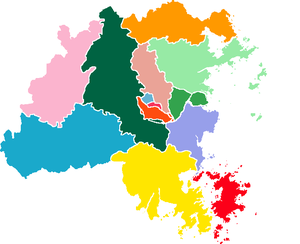
|
Subdivision | |||||
|---|---|---|---|---|---|---|
| مدينة فوجو نفسها | Fuzhou Suburban and Rural | |||||
| ■ Gulou-qu | 鼓楼区 | Gū-làu | ■ Fuqing-shi | 福清市 | Hók-chiăng | |
| ■ Taijiang-qu | 台江区 | Dài-gĕ̤ng | ■ Changle-shi | 长乐市 | Diòng-lŏ̤h | |
| ■ Cangshan-qu | 仓山区 | Chŏng-săng | ■ Minqing-xian | 闽清县 | Mìng-âu | |
| ■ Mawei-qu | 马尾区 | Mā-muōi | ■ Minhou-xian | 闽侯县 | Mìng-chiăng | |
| ■ Jin'an-qu | 晋安区 | Céng-ăng | ■ Yongtai-xian | 永泰县 | Īng-tái | |
| ■ Lianjiang-xian | 连江县 | Lièng-gŏng | ||||
| ■ Luoyuan-xian | 罗源县 | Lò̤-nguòng | ||||
| ■ Pingtan-xian | 平潭县 | Bìng-tàng | ||||
| Location | Area(km²) | Resident population | Registered Population |
|---|---|---|---|
| Fuzhou | 12,153.31 | 6,760,000 | 6,303,043 |
| - Gulou District | 36.60 | 584,531 | |
| - Taijiang District | 18.28 | 325,172 | |
| - Cangshan District | 139.41 | 456,531 | |
| - Mawei District | 254.33 | 164,163 | |
| - Jinan District | 566.45 | 328,806 | |
| Minhou County | 2,133.03 | 560,000 | 645,195 |
| Lianjiang County | 1,190.67 | 550,000 | 613,354 |
| Louyuan County | 1,081.17 | 200,000 | 254,111 |
| Minqing County | 1,468.90 | 240,000 | 301,334 |
| Yongtai County | 2,243.41 | 270,000 | 352,854 |
| Pingtan County | 371.09 | 350,000 | 380,721 |
| Fuqing City | 1,932.43 | 1,190,000 | 1,231,288 |
| Changle City | 717.54 | 670,000 | 664,983 |
معرض صور
أفق المدينة
صور أخرى
Flower Lane Church (花巷堂)
Mawei Harbor, old battlefield of Battle of Foochow
البلدات التوأم - المدن الشقيقة
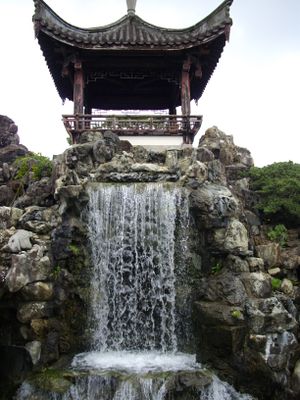
Fuzhou is twinned with the following cities:[48]
| Country | City | County/District/Region/State | Date |
|---|---|---|---|
| ناگاساكي | ناگاساكي | October 20, 1980[49] | |
| ناها | اوكيناوا | May 20, 1981[49] | |
| سيراكيوز | نيويورك | August 25, 1991[49] | |
| Tacoma | Washington | November 16, 1994[49] | |
| كامپيناس | ساو پاولو | November 8, 1996[49] | |
| Shoalhaven | جنوب غرب ويلز | October 15, 2003[49] | |
| Georgetown | Demerara-Mahaica | May 17, 2006[49] | |
| Koszalin | West Pomeranian Voivodeship | May 19, 2007[49] | |
| ممباسة | Coast Province | May 19, 2008[49] |
تبادلات صداقة مع المدن التالية:
| Country | City | County/District/Region/State | Date |
|---|---|---|---|
| Pyeongtaek | Gyeonggi-do | August 26, 2002[50][51] | |
| Gwangyang | Jeollanam-do | Sep 3, 2009[50][52] |
انظر أيضاً
- فوژو (شعب)
- فوژو (لهجة)
- Min Dong language
- قائمة المدن في جمهورية الصين الشعبية حسب التعداد
- معركة فوژو
- سيبو
الهامش
- ^ Cox, W (2018). Demographia World Urban Areas. 14th Annual Edition (PDF). St. Louis: Demographia. p. 24. Archived (PDF) from the original on 2018-05-03. Retrieved 2018-08-06.
- ^ أ ب ت ث "Fuzhou Municipal Statistic Bureau". Fuzhou.gov.cn. Archived from the original on 2012-03-20. Retrieved 2012-04-06.
- ^ Cox, W (2018). Demographia World Urban Areas. 14th Annual Edition (PDF). St. Louis: Demographia. p. 24. Archived (PDF) from the original on 2018-05-03. Retrieved 2018-08-06.
- ^ "Fuzhou". Lexico UK English Dictionary. Oxford University Press. Archived from the original on September 26, 2020.
- ^ "Illuminating China's Provinces, Municipalities and Autonomous Regions". PRC Central Government Official Website. Archived from the original on 2013-12-10. Retrieved 2014-05-17.
- ^ خطأ استشهاد: وسم
<ref>غير صحيح؛ لا نص تم توفيره للمراجع المسماةpopstats - ^ Jesus Leal Trujillo, Joseph Parilla (فبراير 10, 2015). "The World's 10 Fastest Growing Metropolitan Areas". Brookings Institution. Archived from the original on يوليو 21, 2018. Retrieved يوليو 21, 2018.
- ^ 2016中国城市综合发展指标发布 北上深位列三甲. Archived from the original on 2017-03-25. Retrieved 2017-03-24.
- ^ "Leading 200 science cities | Nature Index 2022 Science Cities | Supplements". Nature Index. Nature (in الإنجليزية). Retrieved 2022-11-27.
- ^ Zhongguo Gujin Diming Dacidian (中国古今地名大词典), (Shanghai: Shanghai Cishu Chubanshe, 2005), 3116.
- ^ Sladen, Douglas (1895), "Bits of China", The Japs at Home (5th ed.), New York: New Amsterdam Book Co., p. 279, https://archive.org/stream/japsathome00sladuoft#page/276/mode/2up.
- ^ أ ب Xu Xiaowang (徐曉望), 2006. Fujian Tong Shi 福建通史, Fujian People's Publishing 福建人民出版社.
- ^ Records of the Grand Historian, Yue Wang Goujian Shijia 越王勾踐世家.
- ^ Yu 1986, p. 456.
- ^ Yule 2002, p. 124.
- ^ Jacques Gernet (1996). A history of Chinese civilization (2, illustrated, revised ed.). Cambridge University Press. p. 420. ISBN 0-521-49781-7. Archived from the original on 4 يونيو 2013. Retrieved 14 ديسمبر 2011.
Foochow was reserved for trade with the Philippines (a similar role had been assumed by Ch'iian- chou between 1368 and 1374 and again after 1403 in the Yung-le era)
- ^ Spence, Jonathan D., The Chan's Great Continent: China in Western Minds, 1999, W.W.Norton & Company, ISBN 978-0-393-31989-7, pp.20–21
- ^ "Treaty of Nanjing 1842 (original text)". US-China Institute. Retrieved 2 February 2020.
{{cite web}}: CS1 maint: url-status (link) - ^ "Treaty of Nanjing (original document)" (PDF). Columbia.edu. Retrieved 2 February 2020.
{{cite web}}: CS1 maint: url-status (link) - ^ *Burton, Margaret E. (1912). Notable Women of Modern China. New York: Fleming H. Revell. p. 42. Archived from the original on 2017-03-16. Retrieved 2017-03-15.
- ^ 中華共和國人民革命政府; Zhōnghuá Gònghéguó Rénmín Gémìng Zhèngfǔ, also known as the Fujian People's Revolutionary Government (福建人民革命政府, Fújiàn Rénmín Zhèngfǔ). Compare 中華共和國 to the shorter, more ambiguous 中華民國 (Zhonghua Minguo, "Folk-state of China"), which was the one-party state under Kuomintang leader Chiang Kai-shek against which Chen and the 19th rebelled (translated into English nonetheless as the "Republic of China").
- ^ 晚清民國史 [History of the late Qing and the Republic]. 五南圖書出版股份有限公司. 2002. pp. 440–. ISBN 978-957-11-2898-6. Archived from the original on 2014-09-25. Retrieved 2016-02-21.
- ^ Hu, Pu-yu (1974). A brief history of Sino-Japanese War (1937–1945) (1st ed.). Taipei, Taiwan: Chung Wu Publishing Co. p. 142.
- ^ Dreyer, Edward L. (1995). China at War, 1901–1949. London, New York City: Longman. p. 107. ISBN 0-521480-01-9.
- ^ Strahan, Lachlan (1996). Australia's China: Changing Perceptions from the 1930s to the 1990s. Cambridge, New York City: Cambridge University Press. p. 235. ISBN 0-582051-25-8.
- ^ أ ب Winchester, Simon. (2008). The Man Who Loved China: The Fantastic Story of the Eccentric Scientist Who Unlocked the Mysteries of the Middle Kingdom (1st ed.). New York: Harper. pp. 143–151. ISBN 978-0060884598.
- ^ Smith, Nancy. "The Freeman Orientation". Wesleyan Alumni Magazine. Wesleyan University. Archived from the original on 20 June 2010.
- ^ "League of Nations Timeline – 1944". Indiana University. Archived from the original on 15 يونيو 2013. Retrieved 5 يوليو 2013.
- ^ 福州有福,完好无损迎来解放. society.people.com.cn. Archived from the original on 2012-06-11. Retrieved 2017-05-06.
- ^ 一·二○”大轰炸60周年 沙县退休职工忆尘封历史. 66163.com. 2015-02-04. Archived from the original on 2017-11-16. Retrieved 2017-05-05.
- ^ 1967,军队介入平息福州武斗乱局 Archived 2017-10-18 at the Wayback Machine.
- ^ 福州万门程控电话开通25周年纪念专题[dead link].
- ^ OPENING TO THE OUTSIDE WORLD Archived 2017-04-26 at the Wayback Machine. China.org.cn
- ^ أ ب Major Events Across The Taiwan Straits Archived أبريل 28, 2006 at the Wayback Machine
- ^ "Archived copy". Archived from the original on 2013-03-18. Retrieved 2014-11-12.
{{cite web}}: CS1 maint: archived copy as title (link) - ^ "Extreme Temperatures Around the World". Archived from the original on 2013-06-25. Retrieved 2010-12-02.
- ^ 中国地面国际交换站气候标准值月值数据集(1971-2000年) (in الصينية المبسطة). China Meteorological Administration. Archived from the original on 2013-09-21. Retrieved 2010-01-22.
- ^ 中国气象数据网 – WeatherBk Data. China Meteorological Administration. Archived from the original on 2017-09-23. Retrieved 2018-11-09.
- ^ "Min Opera". cultural-china.com. Archived from the original on 2012-05-25.
- ^ "China Expat city Guide Dalian". China Expat. 2008. Archived from the original on 2009-02-17. Retrieved 2009-02-08.
- ^ أ ب ت "China Briefing Business Reports". Asia Briefing. 2009. Archived from the original on December 20, 2008. Retrieved 2009-02-08.
- ^ "Fuzhou Economic & Technological Development Zone". RightSite.asia. Archived from the original on 2012-04-18. Retrieved 2012-04-06.
- ^ "Fuzhou Export Processing Zone". RightSite.asia. 2005-06-03. Archived from the original on 2012-04-18. Retrieved 2012-04-06.
- ^ "Fuzhou Free Trade Zone". RightSite.asia. Archived from the original on 2012-04-18. Retrieved 2012-04-06.
- ^ "Fuzhou Hi-Tech Industrial Development Zone". RightSite.asia. Archived from the original on 2012-04-18. Retrieved 2012-04-06.
- ^ "Fuzhou Science and Technology Park". RightSite.asia. Archived from the original on 2012-04-18. Retrieved 2012-04-06.
- ^ "Fuzhou Taiwan Merchants Development Zone". RightSite.asia. Archived from the original on 2012-04-26. Retrieved 2012-04-06.
- ^ http://www.fuzhou.gov.cn/zfb/xxgk/zjrc/yhwl/
- ^ أ ب ت ث ج ح خ د ذ "Fujian Foreign Relations 福建省与国外友城关系一览表". The Foreign Affair Office of Fujian Provincial People's Government. Retrieved 2010-02-09.
- ^ أ ب "Fuzhou: Friendly Exchange Cities 福州国际友好城市概况". the official website of the Fuzhou city. Retrieved 2010-02-09.
- ^ "Friendly Exchange Cities Pyeongtaek 福州市与平泽市于2002年8月26日结为友好交流城市". the official website of the Fuzhou city. Retrieved 2010-02-09.
- ^ "Friendly Exchange Cities Gwangyang 福州市与平光阳市于2002年8月26日结为友好交流城市". the official website of the Fuzhou city. Retrieved 2010-02-09.
وصلات خارجية
| Fuzhou
]].- Fuzhou Government website
- An early history of Fujian and Fuzhou
- فوتشو travel guide from Wikitravel
- Maritime Art - On the River Min
- Fuzhou Daily,a local newspaper
26°04′34″N 119°18′23″E / 26.07611°N 119.30639°E{{#coordinates:}}: لا يمكن أن يكون هناك أكثر من وسم أساسي واحد لكل صفحة قالب:Fujian
- Pages using gadget WikiMiniAtlas
- CS1 uses الصينية-language script (zh)
- Articles containing صينية-language text
- CS1 maint: url-status
- Articles containing traditional Chinese-language text
- Articles containing simplified Chinese-language text
- Articles containing Chinese-language text
- Articles with dead external links from April 2019
- CS1 الصينية المبسطة-language sources (zh-hans)
- صفحات ذات وسوم إحداثيات غير صحيحة
- Short description is different from Wikidata
- Coordinates on Wikidata
- Transliteration template errors
- Articles with hatnote templates targeting a nonexistent page
- Articles with unsourced statements from June 2019
- Articles to be expanded from May 2013
- All articles to be expanded
- فوژو
- مدن في فوجيان
- Prefecture-level divisions of Fujian
- عواصم المقاطعات في الصين
- معاهدة نانكينگ
- صفحات مع الخرائط
